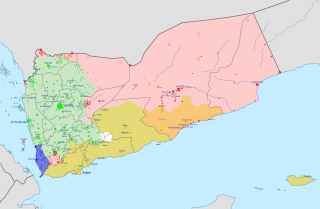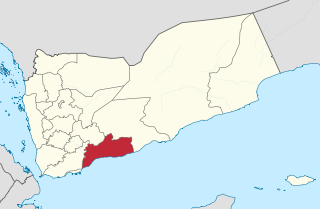
Aden is a port city located in Yemen in the southern part of the Arabian peninsula, positioned near the eastern approach to the Red Sea. It is situated approximately 170 km east of the Bab-el-Mandeb strait and north of the Gulf of Aden. With its strategic location on the coastline, Aden serves as a gateway between the Red Sea and the Arabian Sea, making it a crucial maritime hub connecting Africa, Asia, and the Middle East. As of 2023, Aden City has a population of approximately 1,080,000 residents, making it one of the largest cities in Yemen. Aden is divided into eight districts: Tawahi, Mualla, Crater, Khur Maksar, Al Mansura, Dar Sad, Sheikh Othman, and Al Buraiqa. These form today's Aden Governorate. During British Colonialism, Aden referred to the area along the north coast of the Gulf of Aden, encompassing Tawahi, Mualla, Crater, and much of Khur Maksar District. The western harbor peninsula, known as Little Aden, now falls within the Al Buraiqa District.

Lahej, the Sultanate of Lahej, or, sometimes, the Abdali Sultanate, was a Sheikdom based in Lahij in Southern Arabia. The Sultanate became self-ruling in 1728 and gained independence in 1740. In 1839, the Sultanate became part of the Aden Protectorate of the British Empire, though nominally the 'Abdali Sultan retained his status. The Aden Protectorate was briefly ruled again by the Ottomans during World War I, but regained by the British after the Ottoman defeat in World War I and absorbed into Federation of South Arabia in 1963. The 'Abdali dynasty was officially abolished in 1967, with the proclamation of South Yemen.

Aden is a governorate of Yemen, including the city of Aden. At the 2004 census, it had a population of 589,419. The ancient capital, the port city of Crater, was located here.

Lahij is a governorate of Yemen.

The South Yemen insurgency is a term used by the Yemeni government to describe the protests and attacks on government forces in southern Yemen, ongoing since 27 April 2009. Although the violence has been blamed on elements within the southern secessionist movement, leaders of the group maintain that their aims of independence are to be achieved through peaceful means, and claim that attacks are from ordinary citizens in response to the government's provocative actions. The insurgency comes amid the Shia insurgency in the country's north as led by the Houthi communities. Southern leaders led a brief, unsuccessful secession in 1994 following unification. Many of them are involved in the present secession movement. Southern separatist insurgents are active mainly in the area of former South Yemen, but also in Ad Dali' Governorate, which was not a part of the independent southern state. They are supported by the United Arab Emirates, even though the UAE is a member of the Saudi Arabian-led coalition working to support the Yemeni government.

The Al-Qaeda insurgency in Yemen is an ongoing armed conflict between the Yemeni government, the United States and their allies, and al-Qaeda-affiliated groups in Yemen. It is a part of the Global War on Terror.

The siege of Dammaj began in October 2011 when the Houthis, a rebel group which controls the Saada Governorate, accused Salafis loyal to the Yemeni government of smuggling weapons into their religious center in the town of Dammaj and demanded they hand over their weapons and military posts in the town. As the Salafis refused, Houthi rebels responded by imposing a siege on Dammaj, closing the main entrances leading to the town. The town was controlled by the Houthis and the fighting was mainly centered at Dar al-Hadith religious school, which was operated by Salafis.
"Yemeni crisis (2011–present)" refers to events of the Houthi insurgency in Yemen, the Yemeni revolution, the Al-Qaeda insurgency in Yemen and the South Yemen insurgency.

The aftermath of the Houthi takeover in Yemen refers to developments following the Houthis' takeover of the Yemeni capital of Sana'a and dissolution of the government, which eventually led to a civil war and the Saudi Arabian-led intervention in Yemen.
The Battle of Aden International Airport broke out in the early morning hours of 19 March 2015, when Yemen Army units loyal to former president Ali Abdullah Saleh attacked the airport in Aden, Yemen. The airport was defended by soldiers and guards supporting Abdrabbuh Mansur Hadi, Yemen's internationally recognised president.
Major general Mahmoud al-Subaihi is a Yemeni military officer. He served in the cabinet of President Abdrabbuh Mansur Hadi as defence minister. In the Yemen Army, he holds the rank of major general. He was appointed to head the Ministry of Defence by Prime Minister Khaled Bahah in November 2014.
Al Anad Air Base is a military air base in the Lahij Governorate, Yemen. It is the biggest air base in Yemen.

The Abyan campaign was a 2015 campaign for control of the Abyan Governorate of Yemen, between the Houthis and Yemen Army units loyal to Ali Abdullah Saleh on one side, and militiamen and Yemen Army units loyal to Abd Rabbuh Mansur Hadi on the other side, supported by jihadists of al-Qaeda in the Arabian Peninsula. The pro-Hadi forces recaptured the Abyan Governorate on 11 August 2015, after launching an offensive on pro-Houthi forces in early August.

The Shabwah campaign was a campaign for control of the Shabwah Governorate of Yemen, between the Houthis and Yemen Army units loyal to Ali Abdullah Saleh on one side, and militiamen and Yemen Army units loyal to Abdrabbuh Mansur Hadi on the other side. The offensive was also launched during a previously started AQAP offensive.

The Lahij insurgency was a subconflict in the Yemeni Civil War waged in 2015 by tribesmen loyal to Abdrabbuh Mansur Hadi against the Houthis and Yemen Army units loyal to Ali Abdullah Saleh, who controlled most of the Lahij Governorate of Yemen. In late July, pro-Hadi forces had launched an offensive to recapture Al Anad Air Base and the rest of Lahij Governorate. On 4 August, pro-Hadi forces had retaken full control of the Lahij Governorate.
In early December 2015, two Yemeni towns, Zinjibar and Jaʽār, were captured by the jihadist group Al-Qaeda in the Arabian Peninsula (AQAP). This was the second capture and occupation of Zinjibar during unrest in Yemen. The town was earlier taken by AQAP's in May 2011 and held until the summer of 2012.

The Islamic State – Yemen Province is a branch of the militant Islamist group Islamic State (IS), active in Yemen. IS announced the group's formation on 13 November 2014.
The following is a timeline of the Yemeni civil war, which began in September 2014.
The first confirmed case relating to the COVID-19 pandemic in Yemen was announced on 10 April 2020 with an occurrence in Hadhramaut. Organizations called the news a "devastating blow" and a "nightmare scenario" given the country's already dire humanitarian situation.

Ahmed Fadhl Al-Abdali (1881–1943), commonly known as "al-Qumindan", was a Yemeni poet, composer, and military figure belonging to the "Al-Abdali" family that ruled the Sultanate of Lahej during the British occupation of southern Yemen. Additionally, he was a historian and played a pivotal role in the agricultural renaissance of Lahij. Some even considered him as faqih. al-Qumindan played an active role in the establishment of the Arab Literary Club in Aden in 1925, holding various leadership positions over time. He is regarded as one of the most celebrated poets of the Yemeni dialect, with his oeuvre enjoying considerable popularity in Lahij and the surrounding regions. As a composer, he is regarded as the founder of modern Lahij music, which is regarded as one of the principal musical styles in Yemen, alongside Sanaani and Hadrami music.














